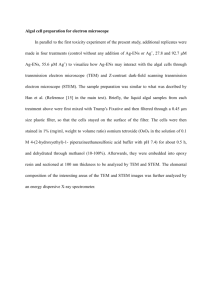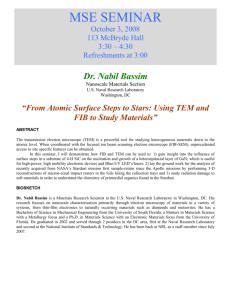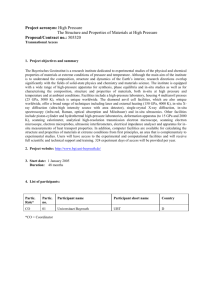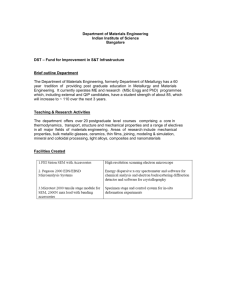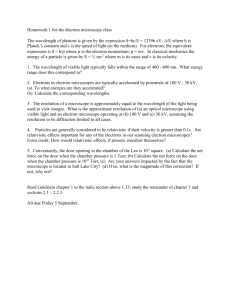TEAM - Frederick Seitz Materials Research Laboratory
advertisement
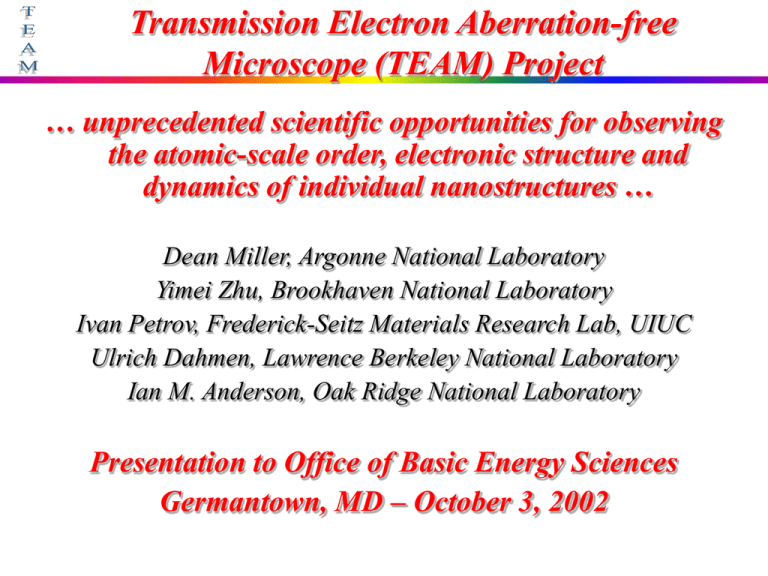
Transmission Electron Aberration-free
Microscope (TEAM) Project
… unprecedented scientific opportunities for observing
the atomic-scale order, electronic structure and
dynamics of individual nanostructures …
Dean Miller, Argonne National Laboratory
Yimei Zhu, Brookhaven National Laboratory
Ivan Petrov, Frederick-Seitz Materials Research Lab, UIUC
Ulrich Dahmen, Lawrence Berkeley National Laboratory
Ian M. Anderson, Oak Ridge National Laboratory
Presentation to Office of Basic Energy Sciences
Germantown, MD – October 3, 2002
… with implications for many important
areas of science!
Feynman anticipates physical basis for chemical
behavior and role of electron microscope
“It would be very easy to make an analysis of any complicated
chemical substance; all one would have to do would be to look at
it and see where the atoms are. The only trouble is that the
electron microscope is one hundred times too poor … I put this
out as a challenge: Is there no way to make the electron
microscope more powerful?”
– Richard P. Feynman, 1959,
“There’s Plenty of Room at the Bottom”
Atomic-scale imaging plays a unique role by defining quantum
mechanical boundary conditions for the electronic structure
calculations necessary to determine how nanostructures work
TEAM: extraordinary new scientific opportunities
for direct observation of individual nanostructures
• three-dimensional atomic-scale structure, shape, and defect distribution
• spectroscopic identification and location of individual dopant atoms
• direct imaging of the atomic-scale structure of glasses
• electronic structure of individual point defects
• non-spherical charge density and valence electron distribution
• in-situ synthesis of novel nanoscale structures
– e.g., electron-beam lithographic removal of individual columns of atoms
• in-situ observation of the synthesis of individual nanostructures
• in-situ observation of processing methods
– e.g., thin film growth, oxidation, and deformation
• in-situ scientific investigation of dynamic materials responses to
variations in external thermodynamic variables
– e.g., temperature, pressure, stress, chemical activity, and applied electric
and magnetic fields
… all with unprecedented spatial, spectral & temporal resolution
Why now?
A remarkable breakthrough has occurred in electron optics
• Development of revolutionary
aberration-correcting devices
Haider
1
(200keV)
dramatically improves achievable
Dietrich
numerical aperture in electron
(200keV)
0.1
optical systems
Electron Microscope
• This breakthrough removes the
Marton
0.01
barrier that has limited the
performance of the electron
microscope since its invention
0.001
Ruska
Light Microscope
• Simultaneous advances in stability
Abbe
of electronics, efficiencies of
Amici
0.0001
detectors, and speed of computers
Ross
enable new opportunities for
scientific investigation
1800 1840 1880 1920 1960 2000 2040
-1
Resolution (Ang.)
Corrected EM
Year
What does aberration correction buy us?
1200
Intensity
1000
800
600
Higher probe
intensity!
0.8 Å
1.2 Å
2.0 Å
Smaller probes!
400
200
0
-4
-2
0
2
4
More signal!
distance (Å)
Greater sensitivity!
Greater contrast!
TEAM focus:
Aberration correction also buys us space!
Space for controlled
• Aberration correction specimen deformation!
allows lenses with
order of magnitude
longer focal lengths
at same resolution
Space for 3D
specimen rotation!
• Flexibility in
instrument design
allows in-situ
studies of dynamical processes
Space for in-situ
synthesis &
characterization
• Modular approach
to allow individual
scientists to develop
custom modules that
address specific
scientific questions
Microscope becomes a self-contained materials science lab!
Modular sample holder configurations enable
in-situ measurements of materials behavior
Modular MEMS specimen
holder
for in situ studies
Electron
transparent
window
(Initial designs can be employed in current
generation microscopes.)
Transportable
specimen holder
MEMS specimen
Volume available
for experimental
tools
Feed-through
Wide-bodied
stage
Electron
transparent
window
Front-end of stage
DOE Basic Energy Sciences Microcharacterization User Centers, FS-MRL, ANL, BNL, LBL, ORNL
The TEAM project: a science-based approach
for the development of aberration correction
• Unique, state-of-the-art instruments designed to achieve
the full potential of aberration-correcting optics
– Hybrid instruments operating or on order today interface an
aberration correcting device to an earlier generation microscope
• Instruments tailored to in-situ scientific investigation of
materials behavior at the nanoscale
– Instruments designed in collaboration with non-microscopist
scientists to address specific classes of scientific problems
• Unique instrumentation and supporting expertise broadly
available to general scientific community
– Impact of investments maximized through location of
instruments within outward looking user centers
Status of TEAM Project
• First TEAM Workshop held following 2000 Stringer BESAC
Panel Review endorsement of TEAM “vision document”
• Scientific Advisory Committee established
– C.B. Carter, U Minnesota; J.A. Eades, Lehigh U; J. Silcox, Cornell U;
J.C.H..Spence, Arizona State U; R. Tromp, IBM
• Second TEAM Workshop, July 18-19, 2002 at LBNL, comprised
115 participants from 47 institutions
– Strong participation from microscopy and general science communities,
with strong expressions of support for project
• Both TEM and STEM approaches to aberration correction under
commercial development
– Second generation TEM & STEM aberration correctors designed
• TEAM Advisory Committee recommends BES EBMCs develop
full proposal to fund TEAM
Broad-based TEAM Workshop participation:
18 universities, 13 companies, 7 national labs, 8 foreign & DOE
Stanford University @ Massachusetts Institute of Technology @
University of Illinois - Urbana Champaign @ Lehigh University
@ Arizona State University @ University of Illinois - Chicago @
Case Western University @ North Carolina State University @
Vanderbilt University @ Northwestern University @ UC Davis
@ University of Washington @ UC Santa Cruz @ UC Berkeley
@ Oregon State University @ University of Minnesota @ AMD
@ University of Pittsburgh @ Dupont @ Lumileds @ Gatan @
PNNL @ Hitachi @ IBM @ JEOL @ Lucent @ MMFX @ FEI
@ LBNL @ LLNL @ ORNL @ BNL @ Intel @ Nion @ PGI @
ANL @ SNL @ Simon Fraser University @ Chalmers University
@ National Tsing Hua University @ Regensburg University @
Monash University @ University of Orsay @ CEOS @ DOE
@@
TEAM 2002 Workshop:
Scientific challenges identified
• Nanomaterials – Dresselhaus, MIT
– Synthesis, properties, assembly: electronic structure
• Semiconductors – Eaglesham, Lucent
– The end of the roadmap in Si technology: multiple nanoscale issues
• Magnetic materials – Siegmann, ETH
– Fundamental understanding + utilization of magnetic nanostructures
• Photonic materials – Craford, Lumileds
– GaN will revolutionize the lighting industry: dopants, point defects
CO
e-
O2
• Computational materials science – Diaz de la Rubia, LLNL
CO 2
O2-
Pt
Ti 3 +
Ti 4 +
– Convergence of theory and experiment: validate theory
• Catalysis – Gai, Dupont
– Energy, environment, transportation: controlled chemical processes
Aberration correction will create fundamentally new opportunities!
Opportunity for BES
Locating TEAM at existing EBMCs maximizes scientific impact
• Well established user programs with missions that are aligned
with BES science goals
• Proximity to nation’s BES-sponsored synchrotron light and
neutron sources
• Closely coordinated with BES-funded Nanoscale Science
Research Centers (NSRCs)
• Necessary infrastructure to support unique capability
– broad scientific base, advanced scientific computing, technical support, etc.
• Strong record of instrumentation, technique development
• Extraordinary level of coordination among EBMCs in the
development of electron beam microcharacterization user centers
in general, and the TEAM initiative in particular
The TEM as a materials science laboratory:
atomic-scale synthesis and characterization
New science enabled
by TEAM:
Paradigm shift
from 2D to 3D
UHV-TEM
Current stateof-the-art:
LEEM
STM
•
In-situ measurements of
behavior of individual
nanostructures
•
Direct 3D atomic-scale imaging of the
synthesis of nanostructure in a controlled
environment
•
3D self-assembly controlled by
surface segregation
– In-situ chemical probes
New science through in-situ
multi-probe measurements
CNT
TEM
•STM/AFM
•Four-point probes
•Indentation
•Magnetic/
electric probes
STM
STM
Doped nano-peapods; Yazdani, Science, 2002.
e-
Science of catalysts: 3D atomic-scale
morphology, composition, and chemical state
Current state-of-the-art:
At right, fuel cell Cu/ZnO catalyst
particles changing shape in response
to gaseous environment; Hansen et
al., Science 295, 2055 (2002).
New science enabled by
TEAM:
Model system for redox catalysis:
Oxidation of CO by Pt on titania
CO
e-
Key Scientific Questions:
O2
CO 2
O2-
Pt
Ti 3 +
Ti 4 +
• How does 3D morphology of catalyst particle and its
wetting to oxide support vary with T, {pi}, i = O2, CO,
CO2, etc.?
• How is oxygen transported to particles to effect redox
reaction (e.g., CO to CO2)?
• What is physical extent of chemically reduced area of
substrate in vicinity of active metal particle?
Science of semiconductors: 3D atomic-scale
elemental distribution and nanoscale structure
Current state-of-the-art:
New science enabled
by TEAM:
Local 3D elemental
distribution through:
• Atomic resolution TEM
& STEM tomography
• Single atom sensitivity
in STEM across most of
periodic table
Local nanoscale
structure through:
• Nanocrystallography
P.M. Voyles, D.A. Muller et al., Nature 416, 826 (2002)
Local elemental distribution key to developing GaN for solid state
lighting; N, O distribution, amorphous material key for Si gate oxide
Science of superconductors: simultaneous
imaging of structural defects, magnetic fields
Current state-of-the-art:
Lorentz micrograph of chain-lattice
state of vortices in Bi-2212 film
SCIENCE 294, 5549, 2136 (2001)
New science enabled by TEAM:
●
Location of vortices relative to
“pinning” structural defects via
simultaneous high resolution and
magnetic imaging
●
Magnetic structure in vortex core
●
Proximity effects at interfaces
(e.g., magnetic superconducting)
Methods
●
●
Resolution limit of 2 nm
insufficient for simultaneous
imaging of structural defects
●
●
●
Phase reconstruction (Coene, Thust):
defocus series enable long exp.times
Cs-corrected Lorentz TEM
Electron Holography
Lorentz STEM (0.1 nm dedicated)
Science of nanoscale functional materials:
non-spherical charge density, electron orbitals & spin
Current state-of-the-art:
B
B
Valence electron distribution in MgB2.
Left: 2D line
H=170
Oe
0 Oe
35
H=300
Oe
Oe
contour;
Right: 3D map
New science enabled by TEAM:
• Non-spherical charge density &
electron orbitals via quantitative
small-angle electron scattering
• Structure, bonding in aperiodic
and amorphous materials
• Scientific understanding of spin
dynamics & switching behavior
of magnetic nano-arrays
Methods
●
●
Local magnetization & induction
distribution of magnetic Co arrays
●
Development of ultra-fast (104 frames/s)
solid-state detector
Position-sensitive, coherent interferometric
diffraction for 5D structure (3r + 2q)
Real-time phase retrieval for in-situ
mapping of electro- & magneto-static
potential, field
Conclusion: TEAM will enable scientific
discovery that can’t otherwise be achieved
• Science-based approach for the development of aberration
correcting electron optics
• Unique in providing 3D atomic-scale structure and dynamics of
individual nanostructures
– From 2D to 3D; from atomic columns to atoms ; from static to dynamic
• TEAM concept transforms electron microscope from imaging
instrument into self-contained materials science laboratory
– Individual scientists able to develop experimental modules that interface
with unique TEAM microscopes to address specific scientific questions
• New opportunities for materials discovery through combined
atomic-scale characterization and in-situ synthesis
– Direct observation of nanoscale synthesis at atomic resolution
• Feynman’s Holy Grail: unique role by defining the quantum
mechanical boundary conditions for the electronic structure
calculations necessary to determine how nanostructures work

